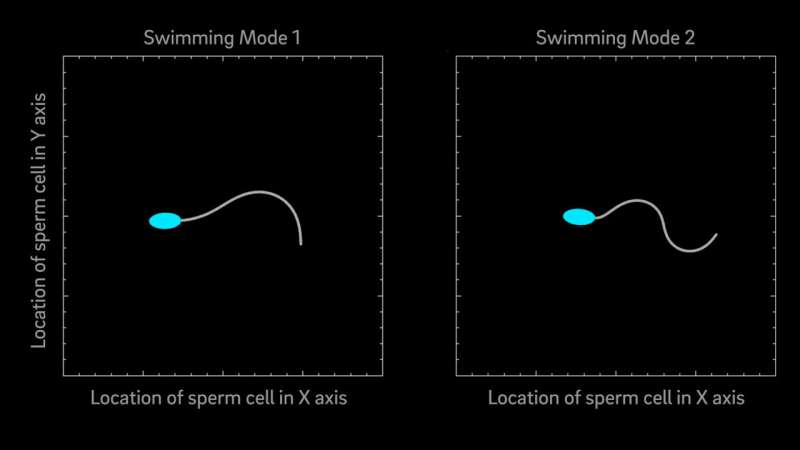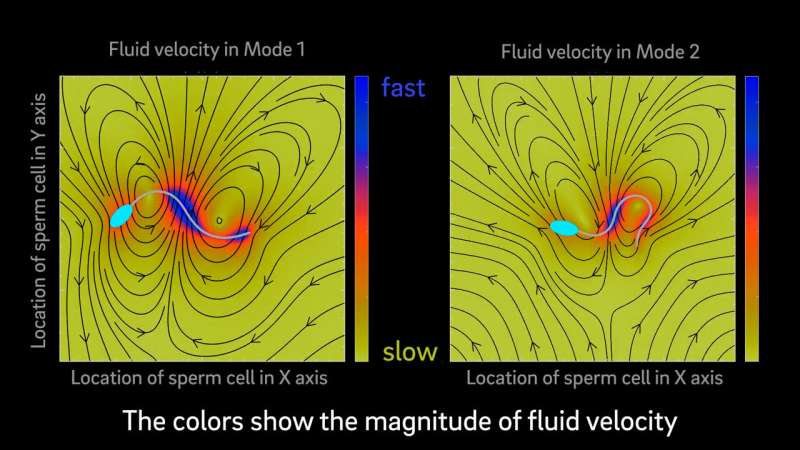This article has been reviewed according to Science X's editorial process and policies. Editors have highlighted the following attributes while ensuring the content's credibility:
fact-checked
preprint
trusted source
proofread
Model suggests that mammalian sperm cells have two modes of swimming

A new mathematical model predicts that mammalian sperm cells have two distinct swimming modes. This prediction opens new questions about potential connections between sperm cells' motor activity and their transitions to hyperactivation phases that may play an important role in fertilization. The finding is part of a larger effort to use math and fluid dynamics to describe how mammalian sperm move
The research is led by a team of engineers at the University of California San Diego, and the work is forthcoming in the journal Physical Review Fluids and a preprint is currently available on the arXiv server.
Mammalian sperm cells propel themselves by beating their flagella back and forth, thanks to chemically powered motors that drive waves along their flagella, which are threadlike appendages.
The researchers' new model of a swimming sperm cell captures the interactions between its motor kinetics and changes in the shape (deformations) of the flagella as well as the movements of the head of the sperm cell. The model also accounts for the complex fluid mechanics around the sperm cell as it moves.
This new model predicts that the swimming speed of a mammalian sperm cell does not simply increase as its chemical motors' activity increases. Instead, as the motor activity of a swimming sperm cell increases, this motor activity passes a threshold level at which point a second, distinct swimming mode emerges. It is this second mode that could potentially be linked to sperm hyperactivation.
In swimming mode one, the head of the mammalian sperm cell swings back and forth more than it does in swimming mode two. In swimming mode two, the wave-shaped beating of the flagellum is stronger than it is in swimming mode one.
"While we can't state for certain that this new model predicts the phenomenon of sperm hyperactivation that often occurs right before fertilization, it is certainly an interesting possibility. I hope further research will clarify whether the motility transition seen in our model is indeed related to sperm hyperactivation," said UC San Diego Professor David Saintillan, the corresponding author on the new paper and a fluid mechanics researcher in the Department of Mechanical and Aerospace Engineering at the UC San Diego Jacobs School of Engineering.

"There is so much opportunity for engineers and mathematicians to contribute to our understanding of biology. More and more of the models we are working on in the field of fluid dynamics, for example, are emerging as important tools for understanding the dynamics of biological systems like locomotion. In some cases, models allow us to test mechanisms or hypotheses that you can't easily address experimentally. In these kinds of situations, models can be extremely useful," said Saintillan.
The study of the mechanisms involved in mammalian sperm locomotion is an example of a problem where models have played a key role alongside experiments, Saintillan noted. "You can't control the activity of the motors in live sperm cells with the turn of a dial, but with a model such as ours you can speed up or slow down the motor activity of sperm and see how the locomotion changes."
More information: Chenji Li et al, A chemomechanical model of sperm locomotion reveals two modes of swimming, Physical Review Fluids (2023). On arXiv: DOI: 10.48550/arxiv.2210.06343
Journal information: arXiv
Provided by University of California - San Diego





















